Peter MALONE
Saturday, 18 September 2021 19:59
Nowhere Boys: Book of Shadows, The
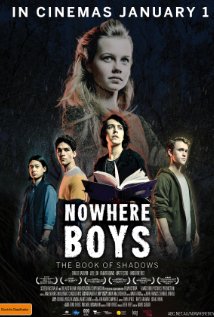
THE NOWHERE BOYS: BOOK OF SHADOWS
Australia, 2015, 83 minutes, Colour.
Dougie Baldwin, Joel Lok Rahart Adams, Matt Testro, Darci Mc Donald, Sean Rees- Wemyss, Angourie Rice, Tamara Shelton.
Directed by David Caesar.
Created by Tony Ayres (The Home’s Song Story), The Slap, Cut Snake), The Nowhere Boys was a very popular television series on the ABC, screened in Australia and overseas. It ran for 26 episodes and was critically received and won awards.
This is the spinoff which will appeal to the young fans of the television series.
There is some recapitulation of the plot of the series for those not familiar with it. The four boys, on a bush excursion, get lost in another time dimension, experience good and evil, magic, and eventually return to their country town of Bremin.
It is now a year later and the group have tended to split, some involved with there own magic (like Andy, the Asian Australian student); like Jake, who is wanting to win a scholarship because of his football talent; like Sam, rather self-centred, skateboard champion, modelling some of the clothing gear and sought after for autographs. Still focused on the magic is Felix who works with his wheelchair-bound brother, Oscar. The four have magic powers and they represent Earth, Air, Fire, Water.
The two brothers are examining a lair that they have found with all kinds of magic and, when they discover a book hidden under the floorboards which they cannot open, it is time to get the full group together for combined magic – which works but at the cost of surrendering the talisman they found in the other world, dividing it into four, but giving each magical powers.
In case this looks to male-oriented, the boys have girlfriends in the school, Mia likes Sam but is irritated by his vanity, Ellen likes Felix, and Andy’s sister is exasperated with his imposing on her to take photos of his magic exploits.
But then comes Tegan from another world whose quest is to recover the magic book and destroy it. She becomes friends with the other girls and enables them to have powers – not above some “mean girls” upsetting other students at school and tipping the boys over and mocking them.
Obviously, it is all building up to a confrontation, also involving the brothers’ father who seems to have magic connections, some protectors from the other world who try to get order out of confusion, and some popping back into the alternate world by Andy to see a girlfriend; Sam is lost in “negative space” and its darkness, before all combine to overcome the dark side.
There are some references to Harry Potter – and so this is kind of Antipodean variation on Harry Potter stories and magic.
1. An Australian television series, television film development? An Australian fantasy, time travel, magic in spells?
2. Harry Potter references, the story of magic in the antipodes?
3. ABC television, the 26 episodes, characters, story, time travel, lost boys, fantasy, the return?
4. The town of Bremin, Victorian landscapes, the school, homes, the surroundings? The comparing with the alternate universe, with the past, with the darkness of negative space? The musical score?
5. Introduction to the characters, the re-cap of the original story of the series, their experience, ages, the year passing, going to school, becoming more individualistic, changing?
6. The importance of the lair, Oscar, in the wheelchair, his narration, talking about his brother, the others, himself? Andy, the Asian background, his experiments with magic, getting his sister to photograph them, her reactions? Asian Australians? Jake, sport, the importance of the scholarship, his football, at the practice, his kicking? His parents packing? Sam, the skateboard champion, modelling, the sports clothes, his vanity, performance, people wanting autographs? Felix, in control, in the lair, wanting everybody to connect, the discovery of the book, his not being able to open it? The emergency call to Jake and Sam and their responding, despite the important things for their own lives?
7. The elements: earth, air, fire, water? Each one representing these elements? Others, including Ellen and her gift of water?
8. Their banding together, the spells, opening the book, the devotion to the talisman, the decision to break the talisman, each having their own magical powers? The repercussions – and the humour with Sam losing his eyebrow and Mia and her disdain of his self-centredness, with the tweezer? The differences between them? On their own?
9. Ellen, her friendship with Felix and Andy? Their cutting her out? Her girlfriends? Interested in forming a girls’ group?
10. The girls, Ellen, Mia and her attitude towards Sam, Andy’s sister? At school? Knowing about the gifts?
11. The guardians, the vision of the boy, the adult women, watching over the universe, order and confusion?
12. The past, the arrival of Tegan, pretty, charming? The quest to get the book back? Going with the group of girls, immediately becoming friends, the
confrontation and humiliation of the boys, bowling them over, getting the powers, mocking the boys? Their using the powers like mean girls at school,
upsetting other students? Visual best friends forever,Ellen and her loyalty to the boys, the betrayal of Tegan? The importance of the book, Felix and Oscar’s parents, the experience of the mother in the kitchen, the father, seemingly absent-minded, their finding him in the school annual, his singing Gilbert and Sullivan, his connection with the books and spells?
13. Sam, his going into negative space, the darkness, finding a bridge, the rescue, returning?
14. Andy, going back into the past, the girl, love for her, moving in and out of time, her acceptance of this time travel?
15. The build-up to a climax, Tegan and her taking the powers from the girls, the dramatic confrontation, the boys' magic winning out?
Published in Movie Reviews
Published in
Movie Reviews
Tagged under
Saturday, 18 September 2021 19:59
Third Person
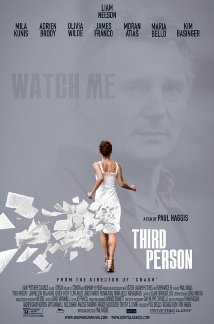
THIRD PERSON
US, 2014, 137 minutes, Colour.
Liam Neeson, Maria Bello, Mila Kunis, Kim Basinger, Adrien Brody, Olivia Wilde, James Franco, Oliver Crouch, Ricardo Scarmaccio, Morran Atias, Vincent Marchioni, Caroline Goodall, David Harewood, Michael Margotta.
Directed by Paul Haggis.
When considering Third Person, it is useful to bear in mind that writer and director, Paul Haggis, won an Oscar for the screenplay Crash, 2005, which also won the Best Picture. Crash was complex plot with a group of people in Los Angeles connected by the crash in question. In Third Person, there are quite a number of characters, also interconnected.
Liam Neeson stars as a writer, separated from his wife, Kim Basinger after the death of their son drowning, in Paris and trying to write. In the early minutes of the film, he turns from his typewriter and hears a child whispering, “Watch me”. This recurs at the end of the film with much more significance.
The author makes some comments about his emotional responses to life and death, noting that in writing, his characters are embodiments of his own feelings and perspectives.
There is a story beginning in Rome with Adrien Brody is an industrial spy, stealing patterns for designer clothes for a cheap market. He becomes involved with a Romanian woman sitting in a bar, reacts when she comes back to find her bag and 5000 euros missing. Her allegedly abducted daughter is involved, the man who has lost his own daughter, becomes infatuated with her, willing to give all his money for herself and for her child.
There is also a New York story, a woman has lost custody of her child because of a violent experience, works as a hotel maid, trying to get to a meeting with a judge and her former husband and his partner to discuss custody and visitation rights. She is late, to the anger of the lawyer and the judge, and clashing with her former husband.
In the meantime, a young writer visits Liam Neeson in Paris, with the on and off again affair, his writing and the complication for the woman and her father.
Towards the end of the film is characters disappear and we are reminded that they are representations of the author and his own experiences and feelings.
The cast includes Olivia Wilde is the woman in Paris, James Franco as the husband in New York, Mila Kunis as his ex- wife, Adrien Brody and the sequence with the Israeli actress, Moran Attias, who is one of the producers film,.
Paul Haggis also won an Oscar for his screenplay for Million Dollar Baby and also directed In the Valley of Elah.
1. A multi-stories film? The focus of the novelist, and his creation of the stories? Audience appreciation of this technique? The voice, “Watch me”, the author looking around? The repetition at the end? The novelist and his comment about the writer and his characters being an outlet for emotions?
2. Paul Haggis, his career, as a writer, Oscars, film direction?
3. The international cast?
4. The Paris locations, the writer’s room, the hotel, the restaurants, streets, landmarks? New York City, apartments, hotels, the studio, the streets, offices? Rome, locations, the venue for the deal, the bar, the road, the city of Foggia, the bars, wharves, views? The musical score?
5. The title, Anna and her questioning of Michael?
6. The introduction of Michael, Liam Neeson, the writer, the recurring scenes of his sitting at his desk, writing? His relationship with Elaine, the phone calls, her grief, love, his leaving her? Anna, arrival, the ticket bought with points, her writing, his bluntness and the notes, his criticism of her outlets in writing and standards? Expectations? The clashes, his carrying her into the room, the sexual encounters, having her own room, wearing the robe, his taking it from her, her running around the corridors nude? Their outings, his gifts? The watch and her putting it in the sink? The time together, angers? Invitation to go to the bar, dancing? Her relationship with Daniel, with him, leaving, the phone call, the revelation that Daniel was her father? The shock? Michael the colour of white, trust? Reading the manuscript, her being in the marketplace, the white dress? The revelation that the phone call when his son was killed was to her? His lying to Anna? Chasing her, her becoming the different women?
7. Elaine, love for Michael, the pathos, the relationship, the death of their child, her wanting him to come home, forgiveness? The truth? His seeing the boy in the fountain? The possibilities of a return?
8. Scott, in Rome, the deal and fashion espionage? His daughter and the phone calls Teresa^? Going into the bar, the surly barman, not speaking English, beer, the old man, Monica’s arrival, Gypsy from Romania? The drinks, talk, her leaving, the story about her daughter, the bag, everybody afraid that it was a bomb, Scott carrying it, the shoes? His return, her coming again, the accusation, the truth about his taking the money? The phone number on the note? Their talk, the issue of $5000? Wanting to pay for her daughter? Refused at the hotel, sleeping at the station, the comparison between the daughters? The drive, her borrowing the car, the encounter with Carlo in Foggia, the $5000, wanting 10,000, upping to 25,000? Scott and the relationship with Monica, whether to believe her story or not, going to the hotel, the sexual encounter? The morning after? The wharf, his waiting, the police, Carlo and the challenge, his being willing to give all his money to Monica? Wiring America for the cash? Their driving away – which aspect of Michael did Scott represent?
9. Rick, in the loft, with the girlfriend, his son, putting his hand in the blue paint, the surly son, storming off, Rick and his paintings? The relationship with Julia? Going to the chambers, her running late, the girlfriend leaving, in the elevator and looking at Julia? The phone call and his agreeing to the meeting, his forcing the truth about her injuring their son, her taking the boy, seen in the lift, her leaving, the bond with her son? The milk, asking her son to care for his father? Which aspect of Michael did Rick represent?
10. Julia, anxious, with Teresa, the custody case, not having money, her mental upset, injuring her child, visitation rights? Going for the job, the kindly man, the uniform, making the beds, the story of her being an actress in soap operas? Writing down the address, the irony of the paper also in Paris with the address, and the number, and seeing it? The extra jobs, paying for the phonecard, not having money in the taxi, the running late? Her plea, the lawyer and a refusal to see Julia? Teresa’s exasperation? Going to the toilet, Rick’s girlfriend and her sympathy? Going to see Rick, admitting the truth, the lift, leaving? In the hotel room – and smashing the roses?
11. Anna, her age, the years and relationship with Michael, the fatal phone call, Elaine knowing about her? Arrival in Paris, the story, the clashes, Michael’s insults, carrying her, the sexual encounter, nude in the corridors, the outings, the dress, the arguments, can to the club, dancing, leaving, her going to see Daniel, the sexual relationship, his pleading, the revelation that he was her father?
12. Teresa, her legal work, with Julia, impatience with her, paying the taxi, pleading with the lawyer, her exasperation – her swimming, the death of their child, the phone calls with Scott?
13. Audience alert with the notepads in Paris and New York? Anna taking the address and phone number, its going into the basket?
14. Michael’s agent, their meeting, his lying to pacify Michael, Michael’s challenge, inability to publish, the writing, the improvement, the possible publication despite the truth?
15. Michael as the focus of the characters, combining them, the end?
Published in Movie Reviews
Published in
Movie Reviews
Tagged under
Saturday, 18 September 2021 19:59
Novo
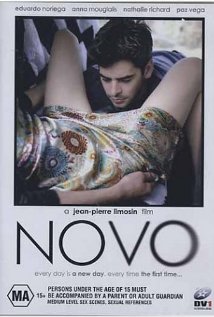
NOVO
France, 2002, 98 minutes, Colour.
Eduardo Noriega, Anna Mougialis, Natalie Richard, Eric Caravaca, Paz Vega, Leny Bueno.
Directed by Jean- Pierre Limousin.
Novo is a drama with comic touches or a comedy with dramatic touches.
The focus is on a young man suffering from amnesia. He thinks he is Graham and works in an office, doing all kinds of jobs, at the beck and call of the manager, Sabine, who exploits him sexually even though she knows who he is and what his background is.
His background is that he is married to Isabelle, Paz Vega, and has a son, Antoine. They try to keep tabs on him, hoping that he will regain his memory. His wife tends to keep out of his way. He has some encounters with his son, liking the young boy and, finally, a lengthy cavorting on the beach with him. A friend, Fred, Eric Caravaca, follows him, trying to keep an eye on him, helping with his memory – although Fred is in love with Graham’s wife.
In fact, Graham is actually Pablo and there are some scenes where he reverts to being Pablo, especially in discussions with doctors and counsellors.
With a nod to such stories as that of Groundhog Day, the film has Graham/Pablo not retaining much of his immediate memory at all, writing notes to himself, trying to establish indications that will remind him.
Into the office comes a young woman, Irene, Anna Mougialis, whom he shows around, pays attention to, goes out with. She becomes infatuated with him and they develop a relationship, his family being aware of this but hoping it will lead to a memory gain. This means that there are some dramatic and romantic interludes, the pathos of Graham/Pablo not remembering and having to establish the relationship over and over again – while there are indications that this relationship is helping him to get some memories back.
Eduardo Noriega was at the beginning of an international career. The screenplay was co-written by the director and ChristophHonore?, his own films later had some preoccupations with sexuality, Ma Mere, Love Songs, Dans Paris. The film is quite explicit in his presentation of the love scenes, the erotic experiences, and a forthright presentation of male and female nudity.
Published in Movie Reviews
Published in
Movie Reviews
Tagged under
Saturday, 18 September 2021 19:59
Ace Ventura, Pet Detective
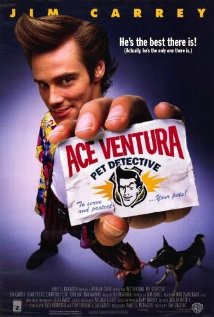
ACE VENTURA PET DETECTIVE
US, 1994, 86 minutes, Colour.
Jim Carrey, Courteney Cox, Sean Young, Tone Loc, Dan Marino, Noble Willingham, Troy Evans, Udo Keir.
Directed by Tom Shadyac.
At the time of its release, this film had huge box office, audiences laughing all around the world. However, it did not appeal to a great many critics, not enthralled by the antics of Jim Carrey.
Up to this time, Carrey had appeared in small roles in a range of films, many of them serious. But he also appeared on television, in the series Living Color, and had made a great impression.
Gambling on his comic talent, producers made this film and Carrey’s career was more than off and running, followed soon after this by The Mask, Dumb and Dumber, Batman, another Ace Ventura Detective film and then going more and more upmarket with such comedies as Liar, Liar and Bruce Almighty, both directed by this film’s director Tom Shadyac.
In the aftermath of this initial success, it is a good question to ask where Carrey’s talent lies and what is his appeal. First and foremost, he is often a clown, not to be interpreted as a real-life person, but someone whose personality is exaggerated, whose mannerisms are excessive and appealing for laughter, someone whose appearance is also exaggerated as well as his manner of speaking. Carrey is noted for his ability for facial contortions, mimicry in different voices, disguises, eyebrow raising, various memory tics, his mobile body.
One of the features of Ace Ventura is that he is certainly not dumb nor dumber. This is clear as the comedy, that despite all his mannerisms and pratfalls, the physical comedy, the touch of the leering, the innuendo and the not exactly innuendo, his character is intellectually smart, knowledgeable, and, in fact, his very effective as detective.
Because he is a detective, the screenplay has many opportunities for him to interact with animals, liking them, disliking them, fighting them, rescuing them, the opening sequence making us misjudge him as he carries on with a tough guy and steals his dog, which was his mission to restore it to its rightful owner. There is also a lot of business with pratfalls, the bashing of his car and his continuing to drive it, battered, looking out the windows.
He is given a commission to find a dolphin, the mascot of the Miami baseball team. His liaison is with the publicity agent, played effectively as straight woman to Carrey’s antics by Courteney Cox just as she was beginning her long presence in Friends. By contrast there is Sean Young as the police chief – with quite some secrets of her own, and turning out to be not only the villain but a man!.
There are quite a number of popular character actors, including guest spot by Udo Keir as a millionaire who is more than challenged at his party by Ace Ventura. There are quite a number of baseball players playing themselves, including Champion Dan Marino who becomes part of the plot, the subject of retaliation by the villain for a spoilt kick in a championship moment and the losing of the pennant. He is kidnapped, rescued, but involved in all the shenanigans.
It is easy to see in retrospect why audiences warmed to him, and it was this kind of persona that he developed for over 20 years while, at the same time, he did make attempts to act in more serious films.
It might be said that Ace Ventura a was a cinema phenomenon.
Published in Movie Reviews
Published in
Movie Reviews
Tagged under
Saturday, 18 September 2021 19:59
Ace Ventura: When Nature Calls
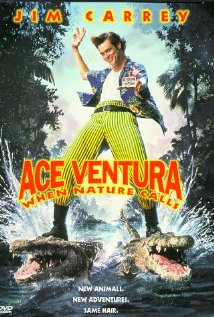
ACE VENTURA WHEN NATURE CALLS
US, 1995, 90 minutes, Colour.
Jim Carrey, Ian Mc Neice, Simon Callow, Maynard Ezrahi, Bob Gunton, Sophie Okonedo, Tommy Davidson, Adewale, Bruce Spence.
Directed by Steve Oderkirk.
With Ace Ventura, Pet Detective being so successful at the box office, it was not surprising that there should be a sequel almost immediately after – and capitalising on the success of The Mask and Dumb and Dumber.
Jim Carrey brings all the characteristics that he developed in the first film, his appearance, facial and bodily mannerisms, the leering touch and the innuendo, the bodily contortions… His best understood if he is interpreted in as an responded to as a clown.As before, there is a lot of physical comedy, plenty of pratfalls – and, this time, plenty of animals to have pratfalls with, culminating in an elephant trampling through cars, houses.
The film was written and directed by Steve Oderkirk who worked on the previous film. With an eye to the various adventure film set in Africa, from King Solomon’s Mines to Hatari, Ace Ventura is on a mission to rescue animals in Africa, getting a commission to find a particular bat which is sacred to a tribe and, with its disappearance, possibilities of fierce warfare with a neighbouring tribe (fostered, of course, by the unscrupulous colonial governor to make money out of white guano).
The villain is played, of all people, by classical actor and writer, Simon Callow, great White Hunter, a crook, very very British. And his offsider, playing the straightman to Carrey’s antics, is Ian Mc Neice. Bob Gunton appears as a local dealer and added villain. Australian Bruce Spence is a lanky Australian poacher.
While there is a lot of African scenery and animals, and plenty of tribal sequences with bad translations from English, poison darts, feats of endurance demanded by the tribe, being swallowed by a rhinoceros…, there is the usual escapades for Ace Ventura.
There is a touch of romance, even with some lewd innuendo, with the Princess of the tribe attracted to Ace. She is played by stage actress, Sophie Okonedo.
This film is slight compared with the original but was successful with its intended audience.
The committee for the Razzie Awards was very unkind to the film, nominating its producer, James Robinson, for worst sequel. The Stinker Bad Awards gave it Most Painfully Unfunny Comedy, Worst Sequel, with nominations for Worst Actor, Jim Carrey, Worst Film and Worst Sequel and The Sequel that Nobody Was Clamouring For!
Published in Movie Reviews
Published in
Movie Reviews
Tagged under
Saturday, 18 September 2021 19:59
Detachment
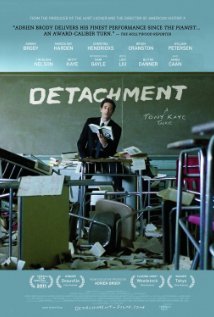
DETACHMENT
US, 2011, 97 minutes, Colour.
Adrien Brody, Marcia Gay Harden, James Caan, Christina Hendriks, Lucy Liu, Blythe Danner, Tim Blake Nelson, William Petersen, Bryan Cranston, Sami Gayle, Betty Kaye, Louis Zorich, Isaiah Whitlock, Josh Pais.
Directed by Tony Kaye.
Detachment is surprisingly involving film. It was directed by Tony Kaye, British director of many music videos and winner of Grammy Awards as well is such films as American History X.
It is a grim picture of American education, but seen through the eyes of the a substitute teacher, Henry Barthes, played very effectively by Adrien Brody, something of a loner, coming into school, confronting students, listening to the staff, who was also something of a Good Samaritan for students in trouble. He also is paying for the care of his grandfather in a home for the elderly. His visits to his grandfather and other occasions lead to flashbacks, his memories of his mother, her behaviour towards him, the behaviour of her father towards her, her suicide, with audiences wondering about the consequences for Henry, the substitute.
The school is run down, the principal, Marcia Gay Harden, seems to be at her wits end, is threatened with the termination of her work, has to host a talk for the staff by a local politician. And, at home, there is a sad relationship with her husband, Bryan Cranston.
A range of character actors have cameos as the staff: James Caan, cheerful bit cynical; Blythe Danner, a veteran; Tim Blake Nelson, ignored by everyone, including his family; and Lucy Liu as the counsellor, trying to help the young students who could not care less, eventually losing everything and blasting one of the students – who still could not care less. Christina Hendriks is a teacher who is attracted to Henry.
One of the students, an overweight girl who likes taking photos, comes on to Henry and he has to calm her down. She takes this badly and kills herself. Sami Gayle is a young prostitute on the streets, accosting Henry on the bus, his giving her something to eat, then taking her in, helping her to clean up, becoming the target of her attachment, but his having to lay down the law and her being taken away by juvenile authorities.
With Henry talking to camera often, he offers quite a deal to think about, not that he is always right, but it is experience from the heart, even though it is a seemingly detached heart.
Audiences will not feel detached in their response to this film.
1. The title, the tone, expectations?
2. Tony Kaye, his varied career, interest in social causes?
3. The focus on education, families and relationships, hard lives and dismal prospects?
4. Henry as the focus, his age, experience, a substitute teacher, his sparse apartment, the loner in life, attached?
5. Henry’s solos to camera, observations, cool, detached, the touch of cynicism, idealism, wanting to help, disappointments?
6. The flashbacks, Henry’s mother, his relationship to her, the colour palette for his flashbacks, red? The place of his grandfather, his mother, dealing with her son, the pills, killing herself? The grandfather and his behaviour towards his daughter? The grandfather old, in hospital, the phone call, Henry losing his temper with the nurse, demanding service because it was being paid for? His visits to his grandfather, talking, reassurance, memories, telling his grandfather he was not to blame?
7. Erica and her vigil, the touch of compassion, his death? Signing the papers, wanting time for grief? The effect of his life with his mother and grandfather and the consequences?
8. The high school, the neighbourhood, the building itself, interiors, classrooms, corridors, the common room? The principal and her office? The assembly room? The counsellor? Education American style, hard, the bad reputation of the school?
9. Henry and his classes, his name, responding strongly to the students, their hostility? Confrontations, reactions? And control? Teaching literature? The final class and the opening of The House of Usher, as an image of their lives?
10. Meredith, spurned by the students, her size, interest in photography, his encouragement? Her responding and thinking it was a come on? In the classroom, talking frankly, touching her, the teacher coming in, false accusations, upset? Meredith disfiguring photos? Setting up the booths, the cakes with the smiles, one for Henry, the one herself, her death, Henry trying to help and revive?
11. Eric in the street, reaction to Henry, on the bus, his being willing to help, her behaviour on the streets, her age? The food at home, after accosting Henry and offering sex? His care for her, the physical damage of the rapes? Her attitude, no family, his taking her to the hospital and having the AIDS test? Her making the meal, tidying up, his not coming home, her upset, the breakfast, his laying down the law – and the supervisors coming to take her away? Her struggle and pleading?
12. The principal, in herself, the end of her term, becoming desperate, the interviews, the meeting with the visiting politician, listening to his talk, the reactions? The threats that she would be ousted because of poor results? At home, with her husband, the tensions in the marriage?
13. The range of teachers and the cameo performances: James Caan, older, the touch of cynicism, his attitude, smiling, sitting on the bench and discussing her outburst with the counsellor, attending the meeting with the politician, his reaction, walking out; Blythe Danner, her years in school, attitude, with students, staff, at the meeting and her reactions; Tim Blake Nelson, despair, in the common room, in the corridors, at home, his wife watching the television, son, standing at the fence desperate, Henry seeingn him, his response to the fact that he was seen? William Petersen? Sarah, her presence, interest in Henry, the meal, coming into the room and seeing Meredith, her instant conclusions? Henry’s disappointment in her?
14. Lucy Liu as the counsellor, in her office, treatment by the students, trying to help, their defiance, detachment? Her exasperation with the girl who had no interest, telling her she would never be a model, and sex with hanging out with friends? The blow up, upset? The truth of what she said? And the girl leaving, not touched by the experience?
15. Henry, at the end of his term, with the class, their asking questions, going to new schools, moving on, his comments about The Fall of the House of Usher?
16. The detachment of the variety of characters and the reasons for this? But the audience not detached?
Published in Movie Reviews
Published in
Movie Reviews
Tagged under
Saturday, 18 September 2021 19:59
In Celebration
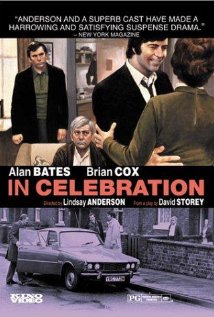
IN CELEBRATION
UK, 1975, 131 minutes, Colour.
Alan Bates, Brian Cox, Gabrielle Daye, Bill Owen, James Bolam, Constance Chapman.
Directed by Lindsay Anderson.
In Celebration is an American Theatre adaptation of the play by David Storey.
The play is set in the house, the mother and father celebrating 40 years of marriage and hosting a visit from their three sons. Also involved in the action is the chatty next door neighbour.
The father is more simple, a miner, relying on his drink. His wife spends a lot of time dithering around the house. It is the three sons who provide psychological studies. Alan Bates is the eldest, giving up his job as a solicitor, trying to be a painter, yet with all kinds of tensions inside, which break out. James Bolam is the second son, successful in his career, with job, car and some status, but alone. A very young Brian Cox is the youngest son, married, with four children.
As might be expected, the dialogue (and silences) between the characters gives rise to a great deal of tense drama, from a seemingly peaceful surface, going into personal depths.
1. From The American Theatre? A filmed play? The work of Lindsay Anderson? The strong cast?
2. The staging, the house, exteriors, interiors? Musical score?
3. A British portrait, characters, tensions, relationships? Places in society?
4. Opening up the play, delineation of characters, their interactions, fluid camera movement, the cues from the verbal to the visual, as with the car?
5. The screenplay, colour photography, the credits, locations, editing and pace, reaction shots? The music and the scene interludes?
6. The title, the little celebration of the 40th wedding anniversary? The ironyies?
7. The background of society: the mines, the pastures, powers, homes, neighbours? The workers? And illusions?
8. The three sons, similarities, differences, their upbringing, relationship with their father, with their mother? To each other? Comparisons? The house and other aspects of their upbringing, memories? Their parents’ reaction to each of them?
9. The opening, small talk, the atmosphere, the ease of the surface, survival – and the later interactions, talk, problems?
10. Dad, tired, 40 years of marriage, memories, the celebration, smoking, the pub, his drinking?
11. Mother, marching down the street, her hat, talking to her husband, human hygiene – top-class? Her dithering about the house?
12. Stephen, the first to arrive, the youngest, his family, his children, his talent, needing a break?
13. Colin, smart, his way of life, the car, the manager type, parking the car, the flowers for his mother, his professional success, yet his loneliness?
14. Andrew, the oldest, thumbing the lift, joking manner, arrival, the comments, giving up his work as a solicitor, painting for a living, his tensions within,
relationship was father, breaking up?
15. The neighbour, calling him, her personality, chatter, illness?
16. The degeneration of the celebration, the visit and the opening up of past wounds, present tensions? The mining background of the parent generation, the ordinariness of their lives, the education for their children, the consequences of the education, their ways of life – but still problems?
Published in Movie Reviews
Published in
Movie Reviews
Tagged under
Saturday, 18 September 2021 19:59
Living Proof
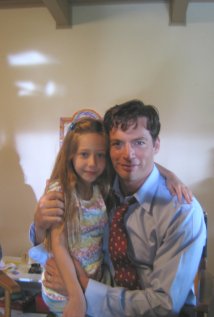
LIVING PROOF
US, 2008, 87 minutes, Colour.
Harry Connick Jr, Tammy Blanchard, Amanda Bynes, Jennifer Coolidge, Angie Harmon, John Benjamin Hickey, Regina King, Swoozie Kurtz, Paula Cale, Amy Madigan, Bernadette Peters, Trudie Styler.
Directed by Dan Ireland.
Living Proof is a portrait of American doctor, Dennis Slamon, his work at UCLA in the 1980s and 1990s, his research into finding medication, different from chemotherapy, something which will slow the growth of breast cancer. The film is a tribute to him and was screened on television 10 years after the acceptance of his breakthrough medication.
Harry Connick Jr seems an unusual piece of casting but is quite effective as Dr Slamon, always intense, committed to his research, sometimes neglecting his wife and daughter, always fighting for a good cause, and becoming very angry with those who hold up the progress of the research – including the board of Genntech, the pharmaceutical company, for whom he works.
Several women characters are introduced so that they will be candidates for the different phases for testing out his medication. Amongst them are Bernadette Peters, an older woman, who has given up on chemotherapy. There is Regina King as a designer and owner of a shop, finding that she has cancer, and finally wanting to become part of the program and put off by people saying that it is not ready. Trudie Styler is a British candidate. Jennifer Coolidge brings her broad humour to her role. Amy Madigan is a supporter.
The pioneer, the first woman to take the medication, is played by Tammy Blanchard, mother of children, urged on by her rather dominating wife mother, Swoozie Kurtz.
Amanda Bynes plays the student who becomes Dr Slamon’s assistant.
Made for television, this is a film which is informative – and an alert to what those who have cancer have to go through.
1. A true life story? The work of Dr Dennis Slamon? The research for medication for breast cancer? A tribute to the doctor, his team and their work? And their responses?
2. A television film, for the wide audience? Audiences identifying with the research, the cause, illness, healing?
3. The impact of the film for women, identifying with the characters, with the cancers, with stage IV and the prognostications? The possibilities for halting the cancer, shrinking the cancer, eliminating?
4. The strong cast, character actors, especially for Harry Connick Jr, and for the women for training those with cancer?
5. The portrait of Dennis Slamon at UCLA, 1988 the following years, his years of research, his memories of his past, healings, his wanting to be a doctor, his laboratory and research? The constant need for grant money? His clashes with the company, the personalities? His friendship with Blake Rogers, urging him on, clashes with him? Rogers’ support over the years? Dr Slamon at home, his long-suffering wife, her support, accepting the demands on him, over time, raising money, support in the emotional crisis over the years? His love for his daughter, regrets at not giving her more time? The image of his long-distance running at the opening – and at the charity at the end, applause and achievement?
6. His work in the laboratory, intensity, Jamie Mc Grath and her arrival, literature major, assigned to him, others not wanting to help? His wariness, urging her away? Her answering the phone, support, work with him over the years, efficient, learning, reading? The emotional impact of the women and their illnesses, possibilities of death and having to tell them? Her wanting to give up?
7. The moving between the laboratory and Dr Slamon home, seeing him as an ordinary person, seeing him as a professional, his confidence and causes in life? The continued tests? Trying to persuade the company?
8. The introduction to the women with cancer? The variety of stories? Their personalities, the experience of cancer, diagnoses, moving to stage IV? The scenes with the various doctors and their communicating with their patients?
9. Nicole, pregnant, her mother and her bossiness, the children, the husband sometimes absent? The birth of the child? The diagnosis of cancer? With the doctors, her mother’s determination, not to give up, reading about the test and the paper, the application? Fulfilling the criteria? The visit with Dr Slamon, her entering into the phase 1, the injection, the test, her improvement? Later not being eligible for the next phase? Her mother coming and pleading? Dr Slamon having to refuse? The doctor later meeting her son and husband, their gratitude, the memory of being the first in volunteering for the tests?
10. Ellie, designer, having her shop, with her friends, going to the doctors, the diagnosis of cancer, the chance encounter with Josh, the meals, the relationship, his proposal, having to refuse because of the limited time? The possibility of entering the experiment? The efforts in getting the documents, coming to the receptionist, saying she was too early, Ellie saying she was too late, his speech about people making the effort and then being given some excuse? Her going into the program?
11. Barbara, at home with her husband, the diagnosis, the facing it, the chemotherapy, the discussions with the doctor, her stopping the chemotherapy? The possibility of entering into the program? Going to Mexico for a diet cure? The doctor ringing during the night? Her accepting, part of the program?
12. The strict criteria, the board member opposed to Dr Slamon’s research, even the possibility of help? His being put in charge? Continual opposition and hindrances? The strict criteria?
13. The range of women, going into the program, Jennifer Coolidge and her wisecracks? Trudie Styler and her British manner? The one woman with the health ingredients? Their being together, the explanations, the chemotherapy, then the injection, the improvements, tumours going down? Yet some not eligible for the next phase?
14. The doctor’s speech to the board? The pressure on Blake Rogers? The interview with the Board? The reliance on Fran Visco and her organisation, the support of Dr Slamon? Her becoming part of the framework of the tests, her condition that those who did not fulfil the requirements were still given the medication – and the woman pleading for her life, her improvement, and her recovery after being allowed the medicine?
15. The background of finance, the continued need for grants, the pharmaceutical company, its attitudes towards health, making money, the board meetings, fear of some kind of fiasco and the danger to the company?
16. Lily, her gratitude for her husband’s health, friendly with Dennis? Her decision to raise money? The dinner, the discussions with the boss of Revlon, the meeting, the decision to give over $2 million? Lily and the continued fundraising? Dennis and his wife present? The need for such business sponsorships?
17. The final approbation for the next phase? The good results? Barbara cleared? The others improving?
18. The finale, the run, congratulations and applause? The film made 10 years after this breakthrough?
Published in Movie Reviews
Published in
Movie Reviews
Tagged under
Saturday, 18 September 2021 19:59
Lake of Fire
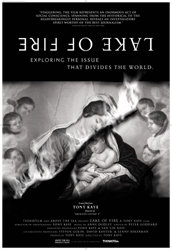
LAKE OF FIRE
US, 2007, 152 minutes, Colour.
Directed by Tony Kaye.
It is not every two and a half hour film, especially a documentary with black and white photography and many talking heads interviews, which can keep audience attention. Despite its length and the fact that it could have been further edited, Lake of Fire does.
On leaving the cinema, I found a video camera in my face, ‘What did you think of the film?’. Taken aback, I found I had said, ‘Good. Emotional. Mentally stimulating’. That still seems a just thumbnail review.
Basically, the film is about abortion and the complex moral issues that the changes in legislation in the last four decades and its repercussions have meant. There is plenty of material here, both intellectual and emotional, to provide solid bases for further discussion and dialogue.
British director Tony Kaye comes from the world of commercials and has the skills to communicate a great deal in thirty seconds or a minute. He also has the talent to tell stories within that space of time. Here he has a great number of minutes, so he packs his film with opinions, visual challenges and stories. It can be noted that he shot his film in the United States (and he was the photographer for his film). All the talking heads (except for Australia’s Peter Singer) are American as are the stories. Kaye began filming in 1993 and most of the footage comes from this period up to 1997 when he began work on the feature film, American History X, a powerfully alarming drama about modern American neo-Nazis with Edward Norton and Edward Furlong. He brings this great interest in fanatic fringe groups to Lake of Fire.
The changes in the legislation concerning abortion and the consequences for American sexual behaviour after the decision in the case Wade vs Roe have led to protests and demonstrations by both Pro- Life and Pro- Choice lobbies. These are the cinematically dramatic element in the film which explores the behaviour, motivation and determination of these groups. Since the Christian Pro- Life groups have been the most active and vociferous, it means that they get the most attention. There is a danger that even the most even-tempered audience will be so appalled by some of their strident behaviour that they will feel that the vociferous and often single-minded protests of the Pro-Choice? lobby, who are not slack in confrontations and shouting of abuse, are models of sobriety compared with their opponents.
In this way the film is particularly American and becomes quite disturbing for a non-American audience. If we have read or seen television reports about the murders of doctors who carried out abortions in Florida, Georgia and Massachusetts and the almost rabid support of their followers in the name of God and Jesus, we might wonder who these people are. Kaye offers a great deal of footage, including interviews, as well as photos of the killings that can help explain but can also defy understanding let alone sympathy.
There is a scene of a police psychiatric interview with John Salvi in 1995 in Florida, a young man who seems clearly mad and who mouthes claims that what he is doing comes from what the Pope teaches, something he is really unable to explain rationally. Paul Hill, who had picketed clinics for months on end and who finished by killing three people, is interviewed during his protests, is seen during his trial and we hear his testimony that, as he is executed (in 2003), he is dying as a martyr for the protection of children. What is truly alarming is his language of execution (in God’s name). One of his followers is interviewed and finishes up by declaring that abortionists, sodomites (which in fact he does not understand) and children who say ‘goddammit’ during a sports match should be executed, the children for blasphemy.
A number of the speakers are religious ministers of Pentecostal churches and pray at their protests in charismatic style. A number of the ministers are rhetoric masters, able to stir crowds and control them – including by fierce radio ministry. A number of the ministers are also part of supremacist groups who advocate arms for all, including training little children with guns. The recurring thought for the ordinary Christian, embarrassed by this morally aberrant behaviour in support of moral principles, is how damning and wrong this is as the face of Christianity – as well as the important question about it all, ‘What would Jesus really think?’.
The amount of material Kaye has collected, the number of interviews with people he has conducted make Lake of Fire a strong documentary on fundamentalist Christians. And the title of his film comes from these Christians who readily relegate ‘sinners’ to an eternal, lava-like sea with people in it burning for eternity. Hell is a Lake of Fire.
This means that Lake of Fire is not just about abortion, not just about the fanatical and violent behaviour of fundamentalist Christians, it is about the nature of scripture and about the nature of God. Again, the discussions and the fanatical rants provide a great deal of varied material on a God who is by and large vengeful against sinners and those who do no follow his ‘law’ (an important factor). While Jesus is the personal saviour, he is not spoken about or prayed to in a personal, experiential way. He is the leader, the master.
Of great significance are the interviews with Norma Mc Corvey who used the name Jane Roe for the Roe vs Wade case. She speaks of her abortion, of the case, the consequences. She also relates how she was contacted by a Pro- Life campaigner, Flip Benham (a born again alcoholic and addict with a frightening grin), and invited to his centre where, after a time of welcome, she changed her attitude towards abortion and has become a campaigner and missioner against abortion.
And the word of God? Preacher after preacher, disciple after disciple, refers to the word of God as absolute, the absolute of absolutes, more than church and definitely more than conscience. But, the bible is read using random quotations without any reference to their context or any work to understand one saying in relation to another. Most of us realise that this is how literal reading of the bible becomes a cause leading to a crusade where so much of religious experience is channelled into apocalyptic fear and aggression.
Throughout this long film, there are a number of speakers. Of interest to Catholic viewers are sections with a woman who is Pro-Choice? and a homily from Cardinal Roger Mahoney of Los Angeles. While there are many women, it is surprising in some ways how many men there are, many more than the women, who are eager to be heard on this issue. There are people in the street, politicians, doctors, religious personalities, writers, philosophers, lawyers. They have differing points of view but thoughtful audiences will appreciate the quieter moments when some of the speakers are calm and present rational reflections. These will differ from person to person in the audience. One of the best of the speakers is Noam Chomsky whose judicious considerations provide much food for thought even when one could take issue with his arguments. So does lawyer Alan Dershowitz as do a number of writers.
Somebody asked if the film was balanced, giving time without bias to each side of the debate. Is it skewed because of the presentation of the loud right without indicating some machinations of the left? Balance is something not achievable in this kind of film, equal time for all opinions. Rather, it gives a great deal of time to a range of opinions, some of them contradictory. But, while the protest scenes will probably confirm Pro- Life protestors in the audience in their stances, the discussion sections offer means for respectful listening to those with whom one disagrees which leads to fruitful debate as well as dialogue.
A challenge that the Pro- Choice demonstrators throw back to the Pro- Life protestors is how do they treat and care for the thousands of unwanted children today who find themselves in institutions and lacking the nurture and care of families. This is something that more temperate Christian groups do around the world rather than spend energy on the crusade.
But, films tell stories and Kaye has wisely left a story until the end. We follow a young women, 28 year old Stacy, who has decided to have an abortion as she goes into the clinic, the physical tests, the interview before the procedure with some questioning as to why she was choosing an abortion. We also go into surgery and see some detail of the abortion procedure itself, especially the emptying of the siphon tube with the parts of the foetus. In fact, earlier in the film, this has been shown in slightly longer sequences – Kaye has not shirked the physical realities of abortion.
Kaye makes this story, which comes to a moving end as the young woman reflects on what the experience has meant to her – and it is very affecting no matter what our moral stances on the issue, for or against. The film ends just rightly.
This storytelling is important otherwise this serious moral issue becomes just a matter of principle. But principles do not exist in the abstract. They are embodied in our behaviour and Lake of Fire offers us a film of principles which are not disembodied.
Published in Movie Reviews
Published in
Movie Reviews
Tagged under
Saturday, 18 September 2021 19:59
Scarlet and the Black, The
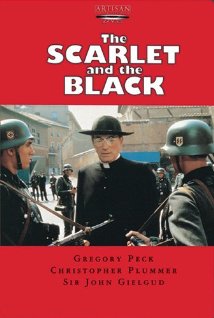
THE SCARLET AND THE BLACK
US, 1983, 134 minutes, Colour.
Gregory Peck, Christopher Plummer, John Gielgud, Raf Vallone, Kenneth Colley, Walter Gotell, Barbara Bouchet, Julian Holloway, Michael Byrne, T.P.Mc Kenna, Vernon Dobtcheff, John Terry.
Directed by Jerry London.
The Scarlet and the Black was originally made for television, for a wide audience.
Interest in World War II, especially the plight of the Jews, has led to many feature films and series, including The Boys from Brazil to Holocaust as well is films like Conspiracy of Parts and later many stories and television films about individuals who helped, especially, the Jews. There have also been controversial discussion about the role of the Vatican and of Pope Pius XII in his dealings with the Nazis. These issues come to the fore in The Scarlet and the Black, and were to be dramatised in Costa- Gavras’ film, Amen (2002). John Gielgud portrays Pius XII with dignity and some heart and the screenplay has him reflect on complex diplomacy and the anxiety and compassion because of immediate needs.
However, the hero of the film is Irish Msgr Hugh O’ Flaherty of the Holy Office who led an organisation from 1943 until the American liberation of Rome in 1944 which helped numerous Allied soldiers to come to Rome and to safety and for their subsequent escape to Switzerland. Thousands of troops benefited by this escape route. While Rome was an open city, it was ruled by Gestapo Colonel Kappler and the relationships with the Vatican were strained.
This true story makes The Scarlet and the Black interesting viewing and often quite tense and exciting. Gregory Peck makes a credible Msgr O’ Flaherty, a man of piety and flair, a man of genuine religion. The original book by J. P. Gallagher was entitled The Scarlet Pimpernel of the Vatican and the film relies on the parallel with that popular and often-filmed story of British espionage: the scene with the wealthy at parties and relying on their financial help behind the scenes, adopting a number of disguises to move around Rome (including seeing Gregory Peck in a nun’s habit as well in a German uniform).
Christopher Plummer plays Kappler with educated and elegant menace and is an excellent dramatic counterpart to Gregory Peck’s O’ Flaherty.
Rome and Vatican settings are important for the film and those familiar with them will relish the way they are used, with the production collaborating with official Italian television’s RAI. In fact, while the film has that feel for the Catholic tradition and language about it, this makes it familiar and welcome.
The film’s director, Jerry London, has worked on telemovies and miniseries, especially Shogun. This means that the film is designed to be acceptable to the widest audience. It has the unhurried pace of the miniseries style as well as the attention to detail, to the skills of storytelling, mood and atmosphere. As regards religion and the church, it has a pleasing blend of humanity and humour. An interesting story of the official church involved in dangerous works of mercy and justice.
Msgr O’ Flaherty assisted Kappler’s family to escape from Rome. And in the years following the war, he visited Kappler in prison every year, in 1959 welcoming him into the Catholic Church.
1. A popular film? World War II memories? Adventures and saving of prisoners from Nazi authorities? A Scarlet Pimpernel story?
2. The significance of Pius XII, his role in Germany as Papal Nuncio, his role in writing Pope Pius XI’s encyclical against the Nazis, Mit Brennender Sorge? The dilemmas about how much should be spoken in public, the danger to Catholics in Nazi-occupied countries? The controversies, the defences?
3. A film made for television, the television audience, the Catholics, non-Catholics, the Jews interested in Pius XII and his stances? Other audiences?
4. The re-creation of the period, Vatican footage, costumes and decor, the religious atmosphere, liturgy and celebrations, clerical dress? The photography, the Vatican, interiors and exteriors? Photography of Rome? The musical score?
5. The tradition of stories about people sheltering escapees, the Jews, military personnel?
6. Gregory Peck as Msgr O’ Flaherty, tall, Irish, his strong accent? His role in the Vatican? Vatican immunity, enabling him to go into action? His interaction with the Germans? With the authorities, with Colonel Kappler? Their discussions, confrontations? His help from various clergy? His international connections, Switzerland, the widow from Malta…? Italy and its change during World War II, the ousting of Mussolini, with the allies, the liberation of Italy by the Americans?
7. Pius XII, John Gielgud in the role, Pius XII and his activities in the 1930s, in the 1940s, his experience with the Nazis? his decisions about whether to condemn the Nazis publicly or not? The sheltering of refugees by Vatican officials? The scene of his confiding in O’ Flaherty about his doubts in the situation?
8. Colonel Kappler, Christopher Plummer in the role? Strongly German, Nazi, authoritarianism? Under Himmler? The other Nazi officials, the various offices in Rome and their roles, to find prisoners, to confront O’ Flaherty? The nature of the German occupation, the relationship with the Vatican, issues of diplomacy? Kappler and his personal story, his wife, the two children? His response to them? Eventually getting O’ Flaherty to help them escape from Rome?
9. German officials in Rome, their personalities, aetiology, the role of the Gestapo?
10. The situation of prisoners, the need for the sheltering of the Jews, for the allied forces imprisoned by the Germans, in Italy? The various helpers in Rome, the widow from Malta and her house? The support of the clergy? The irony of the Irish O’ Flaherty helping the British despite his antagonism towards what the British were doing in Ireland?
11. A final confrontation between O’ Flaherty and Kappler? The Coliseum? Information about the aftermath and O’ Flaherty’s visits to Kappler in prison?
12. A series of adventures, the use of ingenuity and disguises – and the significance of this in the history of World War II?
Published in Movie Reviews
Published in
Movie Reviews
Tagged under